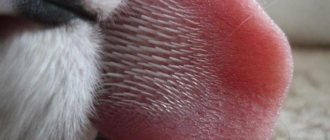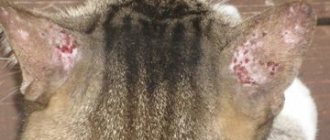Wen on a cat or is it a lipoma that is mobile and painless neoplasm
on the surface of the skin.
It occurs more often in older representatives of domestic cats; it is classified as a benign neoplasm that has connective tissue in its structure. Fortunately, these tumors do not metastasize and do not cause much harm to the health of pets. But this new growth does not always look aesthetically pleasing
.
If you find a lipoma on your furry’s body (and it can be either single or multiple), do not self-medicate, but contact the I-VET Center for Emergency Veterinary Care for Animals. Veterinarians will conduct a detailed diagnosis and then painlessly remove the “uninvited guest” from the body of your beloved cat. For information, let’s say that it is not at all expensive and is available to a wide variety of visitors with any income.
If you are a very busy person and you don’t have a free minute to visit ours, call a veterinarian at home and enjoy comfortable service! Call us at the phone number listed on the website.
Signs and treatment of wen in a cat
A fatty tissue is a neoplasm, which consists mainly of adipose tissue, but may also contain connective tissue. It is benign and does not pose a threat to the furry’s life, but you should definitely make an appointment for your pet to be examined by a veterinarian.
Mostly lipoma consists of fat and is formed in all parts of the body where this tissue is present - this includes subcutaneous tissue and internal organs. Lipoma usually grows slowly. Often it moves deeper into the body, pushing apart the muscles and blood vessels, right up to the periosteum - then its growth is accompanied by painful sensations and impaired blood flow. Treatment is not particularly difficult.
Lipoma can appear in all areas of the body where adipose tissue is present
Most often, the doctor recommends removing the wen, especially if it prevents the cat from living, eating, running normally, or is located in potentially dangerous places (for example, in the neck area). The operation is simple and takes little time. But there are also infiltrating fatty tumors that grow into the thickness of the muscles and blood vessels. They are weakly expressed, and their boundaries are not so easy to determine. Their removal is more difficult and it is these neoplasms that are more often prone to malignancy.
Before intervention, it is necessary to dismiss other diagnoses - cancer, cyst suppuration, other types of neoplasms. Self-medication is absolutely unacceptable and extremely dangerous.
Surgery and postoperative period
If the lipoma is small in size, it can be removed without any complicated manipulations. A small incision is made in the required area, which is subsequently hardly noticeable. In cases where the size of the neoplasm is large, massive pumping of fluid is carried out.
The veterinarian makes a small incision and removes the lipoma.
During surgery for an infiltrative tumor, damaged muscles are also removed, which significantly slows down the cat’s rehabilitation process in the postoperative period.
In the case of liposarcoma, the specialist has to act even more harshly - remove almost all the tissue in contact with the tumor.
During the rehabilitation period, the animal is usually prescribed sedatives and anti-inflammatory drugs. For some time after the operation, the cat will be unable to move independently, so it will have to be kept on a drip to prevent dehydration.
Upon returning home, you should carefully monitor the condition of the surgical suture. You need to ensure that the bandage is firmly attached to the seam and do not allow your pet to lick the wound. If even minor signs of inflammation appear, you should immediately contact your veterinarian.
Reasons for appearance
No one can accurately answer the question of where a particular cat’s wen came from. According to experts, the following are usually to blame for the occurrence of tumors:
- genetics;
- metabolic disorder;
- hormonal disorders;
- old age (most often cats over nine years old suffer from this);
- pathologies of the endocrine system (such as hyperthyroidism);
- sedentary lifestyle;
- accompanying illnesses
Most often, lipoma appears in cats over nine years of age.
It is widely believed that wen is more common in obese individuals. It's a delusion. Of course, excess weight and overeating lead to metabolic disorders and the occurrence of pathologies, which means the risk of lipoma increases, but this depends not only on the weight of the cat. Skinny cats are also at risk of getting sick. At the moment, the main reason for the growth of adipose tissue is considered to be a lack of the enzyme responsible for the breakdown of fat - lipase.
By the way! Sometimes a lipoma can be confused with the activity of ixodid ticks. You can read below about what this type of parasite is and how to remove it from an animal’s body.
Ixodid tick in a cat
Dangerous symptoms
Often, the appearance of a benign formation on a cat’s skin is not accompanied by any additional symptoms, and the animal does not feel any discomfort. However, you need to monitor the condition of the lump, even if it seems harmless.
You should not allow your cat to scratch the swelling, as this can lead to infection of the wound. If the tumor quickly increases in size, looks inflamed, and fluid is oozing from it, you should consult a doctor. This may indicate pathological processes that occur in the animal's body.
Symptoms that should cause concern:
- increased body temperature;
- decline in activity;
- loss of appetite and sudden weight loss;
- nausea and vomiting.
Cones can form locally in a specific location. Most often they can be found on the head, abdomen, neck, and limbs. Sometimes tumors can appear throughout the body. If there are more and more of them, you need to urgently consult a doctor.
Should I delete it?
It is clear that a surgeon’s scalpel does not evoke any pleasant associations. However, the final decision on whether to leave everything as is is made only by the veterinarian. Most often, he opts for surgery and here’s why:
- in some cases, the wen malignizes and degenerates into liposarcoma, which clearly leads to death;
- the wen turns out to be not what it seems (that is, the test shows that it is a tumor of a different kind);
- the wen can compress the blood vessels;
- tumors interfere with the cat's movements.
Lipoma in the neck area must be removed
Attention! If the wen is located in the cat's neck area, it must be removed.
When not to interfere
The veterinarian does not always recommend going under the knife. If the wen does not interfere with your life, you can leave it alone. Thus, the question of surgery is postponed if the neoplasm:
- does not cause pain or serious discomfort;
- small in size and does not grow;
- has no signs of inflammation or pus.
Under no circumstances should you pierce a lipoma, warm it up, or apply lotions. It will not resolve on its own. This can only provoke its growth, and therefore its degeneration into a malignant one.
Lipoma can only be removed by a veterinarian
Should we remove a wen on the neck?
Cervical wen is always cut out, even if it seems that the neoplasm does not bother the cat in any way. In this case, there is always a risk that the tumor will compress important blood vessels and disrupt the flow of oxygen to the brain. The latter is fraught with brain hypoxia and death.
What to do if the lump is bleeding or discharges pus
If the cat owner notices that the tumor has begun to bleed or that pus is oozing from it, then this is a very dangerous symptom that indicates a malignant formation.
Note! Sometimes a cat's lump under the skin on its abdomen can also be an abscess, which can rupture on its own. It is highly undesirable to wait for this, as the pet will experience pain and suffering. Even after septic treatment, pus may still be released for some time, so the wound must be treated and washed.
Very often, cats develop bumps that frighten their owners. The percentage that they are malignant is quite low, so if a neoplasm is detected, you need to take your pet to the doctor’s clinic as quickly as possible for a medical examination and to rule out the worst cases of the disease.
Diagnostics
The diagnosis is made by a veterinarian based on an external examination, as well as X-ray and ultrasound examinations, and histological analysis. Usually, an experienced specialist sees a lipoma immediately, since it has clearly defined boundaries and is easily visible and palpable. But sometimes the tumor arises deep inside, has blurred edges and causes pain. Benignity and malignancy here are determined not by eye, but by the results of examining a tissue sample. In any case, self-diagnosis is unacceptable; the final verdict rests with the doctor.
During the diagnosis, the veterinarian will determine whether the tumor is benign or malignant
If a lipoma sits deep in the internal organs, its presence can only be guessed by indirect signs. To get a complete picture, the veterinarian resorts to modern research methods, such as MRI and CT. They allow you to accurately determine the location and size of the tumor.
Types of lipomas
Fatty tumors are divided into:
- infiltrative;
- non-infiltrative.
It is very easy to work with the first type, since they have clear contours, are easily palpable and visible, and are not connected to neighboring tissues and organs. The second ones are much more serious and imply greater difficulty in removal. This is due to the fact that it is necessary to cut out not only the area under the tumor, but also part of the neighboring tissues affected by it. It is this type of wen that is most prone to malignancy. When treating them, radiotherapy is also prescribed, in addition to surgery, which significantly increases the possibility of a full recovery.
Lipoma from the inside
Treatment
If a pet has developed a wen, there are only two options - either cut it or leave it alone. Usually the doctor recommends removing it and not worrying. The operation is quick, often performed under local anesthesia, and the cat does not experience any pain or discomfort. Moreover, if the tumor is on the neck or the doctor has reasons to doubt its harmlessness.
If the neoplasm does not interfere with anything, they simply do not pay attention to the wen. However, this word here is not entirely true - the owner of the animal does not take any measures against the tumor, he simply regularly takes the cat for examination to monitor the dynamics.
Video - Lipoma in a cat
Before surgery
Most often, the intervention does not present any difficulty for the surgeon and is performed under local anesthesia. The only exceptions are large and difficult-to-reach tumors.
Before intervention, the owner must:
- do not let the cat eat in the last twenty-four hours before being placed on the operating table;
- Give plenty of clean water to drink;
- write down and give the doctor a list of all medications that were given to the animal over the last period.
Attention! If the wen festers or becomes inflamed, the intervention becomes urgent rather than planned.
Special collar for wearing during the postoperative period
Operation
Removing a wen is not difficult at all. The surgeon cuts the skin, then separates the fat capsule from the healthy tissue and removes it. A suture is placed on the resulting hole, which can be removed after about a week to a week and a half.
If the cat has a growing tumor or is located in a hard-to-reach area, more time and care is required. Moreover, if the process affected large spinal nerves. In case of negligence or unprofessionalism, the cat may permanently lose the ability to move. First of all, the surgeon releases the affected muscles, which means that the incision area will be much larger. It will also take longer for the animal to recover from such intervention than after a conventional operation.
Removal of internal lipoma
Recovery
After the intervention, the cat needs rest and care; he is also prescribed sedative and anti-inflammatory medications, antibiotics, depending on the complexity of the situation. If there is a risk of dehydration, the pet is prescribed drips with an electrolytic composition.
When recovering from general anesthesia, a cat may behave differently. Some are tossing around and crying, others are trying to climb higher. It is strictly forbidden to do this to avoid injury. Immediately after the operation, the cat is put on a special protective collar that prevents the cat from licking or injuring the operated area. Symptoms usually go away within a few hours, then the cat returns to normal. Worsening of the condition requires immediate contact with a veterinarian.
After surgery, the cat needs peace and care
Forecast
The prognosis with timely access to the clinic and proper treatment is favorable. This can only be said for sure by studying the whole picture of the cat’s health, taking into account all the existing features and pathologies. Relapses are likely only in the case of germinating tumors.
Does the wen affect the overall well-being of the animal?
Most often, the wen does not interfere with the cat’s life in any way and is discovered by chance, while “stroking.” The exceptions are large tumors, which are also located deep in the internal organs and compress them - here the pet will show with its entire appearance that it is not feeling well. Often the lipoma begins to thicken, bulge, ulcerate, and blood may bleed from it - all these are signs that the mechanism of malignancy has already begun and it is necessary to immediately take the cat to the doctor to schedule an operation. In advanced cases, intoxication may occur from tumor breakdown products entering the bloodstream. So to say that lipoma is imperceptible to cats is to significantly embellish the reality.
It is important to constantly monitor the health of cats with lipoma.
What to do if the wen has opened
If the wen has burst, it is necessary to take the cat to the veterinarian as soon as possible for surgery and removal, since the risk of infection increases sharply. The doctor will remove the purulent contents and fat capsule and apply stitches. In no case should you try to heal the inflammation at home - this threatens the spread of the process and tissue degeneration.
So, lipoma in cats is not at all as harmless as it might seem at first glance. Of course, this is a benign formation, but control over it cannot be weakened, since any “good” can imperceptibly develop into “evil” and it is better to prevent this possibility. The operation is quick, uncomplicated and will not cause any disturbance to either the cat or the owner.
Rehabilitation
The duration of the rehabilitation period after surgery depends on the nature of the lipoma. Restoring your pet’s health after removal of large infiltrative lipomas can take a long time. During this period, the cat needs special care.
It is very important to monitor the condition of the seams. At the slightest suspicion of inflammation, the animal should be taken to a veterinarian. After the operation, you need to put a special protective collar on the cat so that the pet does not lick the wound.
It is also necessary to ensure that the postoperative bandage fits snugly to the body. If the bandages are loose or dirty, then it is necessary to bandage them.
After removal from the cat, a special bandage should be used. This will help protect the postoperative suture from infection.











